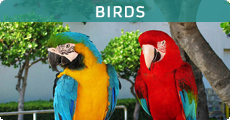Florida State Bird - Mockingbird

They like to breed in open areas as well as dense shrubs; these birds build nests made up of twigs. They guard their nests fiercely and do not allow any other animal or bird to come near their nests. But then if the intruder does not back off, a single mocking bird may call its other associates for help and they would attack their enemy.
The diet of the mocking bird includes insects, berries and seeds. The bird got its name due to its mimicking ability. These birds can mimic sounds made by other birds, animals and even machine sounds. The birds sometimes sing through the night especially during the full moon days. The male birds usually sing more often than the female birds, and the male birds would sing louder than the females.
Mocking birds have a special fondness for certain trees such as maple, sweetgum, and sycamore. They generally avoid pine trees after the other trees have grown their leaves. These birds prefer high altitude rather than the ground, such as the topmost branches of trees and the tops of telephone poles. The mocking birds are rarely seen on ground, while other birds stroll around the ground.
Mockingbirds form a breeding area in the spring and a separate area around a food resource during the non-breeding season, which they must guard not in favor of other fruit-eating birds. Mockingbird pairs may remain together for life, but then some pairs like to form their own territories, this happens especially in the northern part of the range.
March and August are the mating season for these birds. The males usually sing all day long during the mating season, sometimes they also sing in the night. The shape of their nests resembles the shape of a cup. The male mocking bird as well as the female work to build the nests, the nests may be built using twigs, leaves and grass. The female lays between three to five eggs. The eggs are incubated by the females. The eggs require around two weeks to hatch. Both the female and male will take care of the fledglings. The babies leave the nest when they are ten days old. The females are eligible for brooding up to four times a year, but they usually brood for two times e.g., zsZ57N












